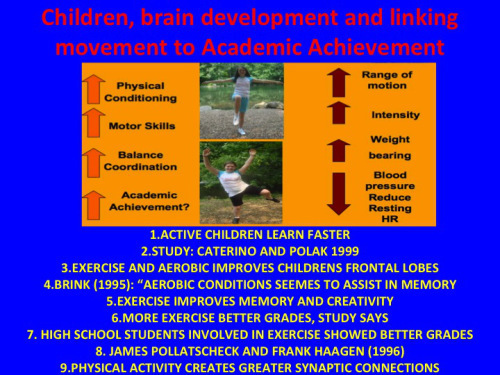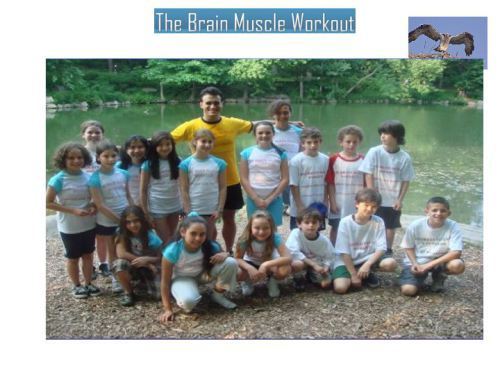Children, brain development and linking movement to Academic Achievement

Children, brain development and linking movement to Academic Achievement
CHILDREN AND BRAIN DEVELOPMENT

brain fitness
Physical exercise is crucial for the present and future of our kids. The kids brain reaches at age of 10, 90% of the total adults size. However, the development of different areas of the brain are very different between kids and adults. In the issue “ The Brain,Discovery June 2007” refers on how kids and teenagers rely more heavily in the frontal cortex that is associated with emotions. The adult has other areas of the brain more activated for decision making. In addition the same frontal cortex will be considered more mature since different parts of the brain get involved in the process of decision making.
STUDY TO READ AND SHARE: “Be Smart Exercise your heart: the effect of exercise on cognition” By Charles Hillman
Super Body, Super Brain School Program will explore that fascinating relationship between the brain and the muscles and help kids to have a better brain reorganization. Super Body, Super Brain School Program will give commands such as (“lunge position, back leg comes front up in the air, hold it and coordinate with an upper body movement”). The benefit will not only be associated to the learning process but with a better organization of the brain when using the powerful cerebellum, part of the brain responsible for balance, coordination and proper execution of physical movement.
“The benefit of training balance and coordination at once will help to have a better reorganization of the brain through the activation of different areas responsible for decision making”
Is Super Body, Super Brain School Program scientifically proven?
Super Body, Super Brain School Program on scientific evidence of different studies based on the brain, physical fitness, balance and coordination. There is extensive research showing the strong correlation between Physical Fitness and a higher academic achievement
SCHOOL PROPOSAL SUPER BODY, SUPER BRAIN

Brain Studies
The cerebellum, the area of the brain responsible for voluntary physical movement is connected by neurons to all parts of the cortex, the area of the brain responsible for higher order thinking. Nearly 80 studies have suggested a strong link between the movement and memory, spatial perception, language, attention, emotion, nonverbal cues, and decision-making (Jensen, 1998).

The Cerebellum
1.ACTIVE CHILDREN LEARN FASTER
“ Dr Hesslow, a Swedish neuroscientist and well renowned cerebellum researchers: “All things being equal a physically active child will have an advantage in learning
2.STUDY: CATERINO AND POLAK 1999
Effects of two types of activity on the performance of second-, third-, and fourth-grade students on a test of concentration.
3.EXERCISE AND AEROBIC IMPROVES CHILDRENS FRONTAL LOBES
4.BRINK (1995): “AEROBIC CONDITIONS SEEMES TO ASSIST IN MEMORY
5.EXERCISE IMPROVES MEMORY AND CREATIVITY
Dustnam research (Michund and Wild 1991 tested three groups: those who engaged in vigorous activity improved in short term, creativity and reaction time
6.MORE EXERCISE BETTER GRADES, STUDY SAYS
CANADIAN STUDY showed how academic scores went up went physical education was increased to one third of the school day (Vanes and Blanchard)
7. HIGH SCHOOL STUDENTS INVOLVED IN EXERCISE SHOWED BETTER GRADES
Students involved in sports showed higher grades than those who didn’t. (1990 TEXAS, High School athletes scored 17% higher than non-athletes)
8. JAMES POLLATSCHECK AND FRANK HAAGEN (1996)
say children who engaged in daily physical education showed superior motor fitness, academic performance than children who didn’t involve in any sport.
9.PHYSICAL ACTIVITY CREATES GREATER SYNAPTIC CONNECTIONS
William Greenough showed how rats that exercised in enriched environments had a greater number of synaptic connections. Exercise improves brain functioning in the following areas: the cerebellum, the basal ganglia, hippocampus or the corpsus callosum.

10. BRAIN ACTIVITY GROWS NEW CELLS (Van Praag 1999)
Aerobic exercise benefits us in many ways. One of hem is that we release endorphins, the class of neurotransmitter that relax us into a state of cortical alertness and reduce the symptoms of depression.
Others effect of exercise are: exercise tends to raise levels of glucose, serotonin, epinephrine and dopamine, chemicals that at elevated levels are to known to inhibit hunger and balance behavior .
11.AEROBIC FITNESS AIDS COGNITION
Aerobic activity not only increases blood flow to the brain but also speeds recall and reasoning skills (Van Boxtel 1996)
12.EXERCISE TRIGGERS BDNF
Exercise releases BDNF a brain derived neurotropic factor that enables one neuron to communicate with another (Kinoshita 1997)

13.CROSS LATERAL MOVEMENT ORGANIZES BRAIN FUNCTIONS
Exercise involving left arm with right leg organizes brain hemispheres.

14. BALANCE IMPROVES READING CAPACITY
the same way our eyes process through the optic nerve, we need to hear it as well. The auditory nerve plays a very important role in the movement process.
Too see my current program how is functioning in one of the best schools in NYC click here
To see my School Program Proposal click here: SUPER BODY, SUPER BRAIN SCHOOL PROPOSAL
Linking Movement to Learning: The Cerebella connection and linking of movement to learning


Michael Gonzalez-Wallace's Blog



